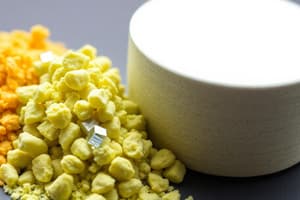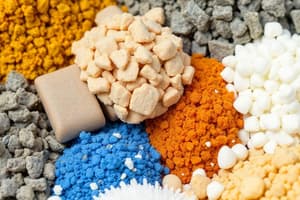Podcast
Questions and Answers
What type of bonding involves the sharing of electrons?
What type of bonding involves the sharing of electrons?
- Composites
- Polymers/plastics (correct)
- Ceramics
- Metals
Which property is relevant to engineers when considering price and availability of materials?
Which property is relevant to engineers when considering price and availability of materials?
- Density (correct)
- Toughness
- Stiffness
- Friction
In which type of material can compounds of metallic & non-metallic elements form ionic bonding?
In which type of material can compounds of metallic & non-metallic elements form ionic bonding?
- Metals
- Ceramics (correct)
- Polymers/plastics
- Composites
Which property is related to the resistance of a material to being pulled apart?
Which property is related to the resistance of a material to being pulled apart?
Which property refers to the ability of a material to absorb energy and plastically deform without fracturing?
Which property refers to the ability of a material to absorb energy and plastically deform without fracturing?
Which property refers to the measure of a material's ability to resist deformation under load?
Which property refers to the measure of a material's ability to resist deformation under load?
What are the properties of metals?
What are the properties of metals?
Which material is an example of a semiconductor?
Which material is an example of a semiconductor?
What is a characteristic property of ceramics?
What is a characteristic property of ceramics?
Which category of materials has a backbone of carbon atoms?
Which category of materials has a backbone of carbon atoms?
Which material is known for its high chemical resistance but low temperature stability?
Which material is known for its high chemical resistance but low temperature stability?
What type of materials are composites?
What type of materials are composites?
What is the example given for advanced materials in the text?
What is the example given for advanced materials in the text?
Which material is known for its piezoelectric property?
Which material is known for its piezoelectric property?
What is the nano-engineered material discussed in the text?
What is the nano-engineered material discussed in the text?
What is a characteristic property of polymers?
What is a characteristic property of polymers?
Which property of materials refers to the measure of a material's ability to resist deformation under load?
Which property of materials refers to the measure of a material's ability to resist deformation under load?
What property is related to the resistance of a material to being pulled apart?
What property is related to the resistance of a material to being pulled apart?
Which type of bonding involves the sharing of electrons?
Which type of bonding involves the sharing of electrons?
What property refers to the ability of a material to absorb energy and plastically deform without fracturing?
What property refers to the ability of a material to absorb energy and plastically deform without fracturing?
Which material is known for its piezoelectric property?
Which material is known for its piezoelectric property?
In which type of material can compounds of metallic & non-metallic elements form ionic bonding?
In which type of material can compounds of metallic & non-metallic elements form ionic bonding?
What is the primary characteristic property of ceramics?
What is the primary characteristic property of ceramics?
Which material is an example of a semiconductor?
Which material is an example of a semiconductor?
What is a characteristic property of metals?
What is a characteristic property of metals?
Which property refers to the measure of a material's ability to resist deformation under load?
Which property refers to the measure of a material's ability to resist deformation under load?
In which type of material can compounds of metallic & non-metallic elements form ionic bonding?
In which type of material can compounds of metallic & non-metallic elements form ionic bonding?
Which property is relevant to engineers when considering price and availability of materials?
Which property is relevant to engineers when considering price and availability of materials?
What type of materials are composites?
What type of materials are composites?
What is the nano-engineered material discussed in the text?
What is the nano-engineered material discussed in the text?
Which property refers to the ability of a material to absorb energy and plastically deform without fracturing?
Which property refers to the ability of a material to absorb energy and plastically deform without fracturing?
Which material is known for its piezoelectric property?
Which material is known for its piezoelectric property?
Flashcards are hidden until you start studying





